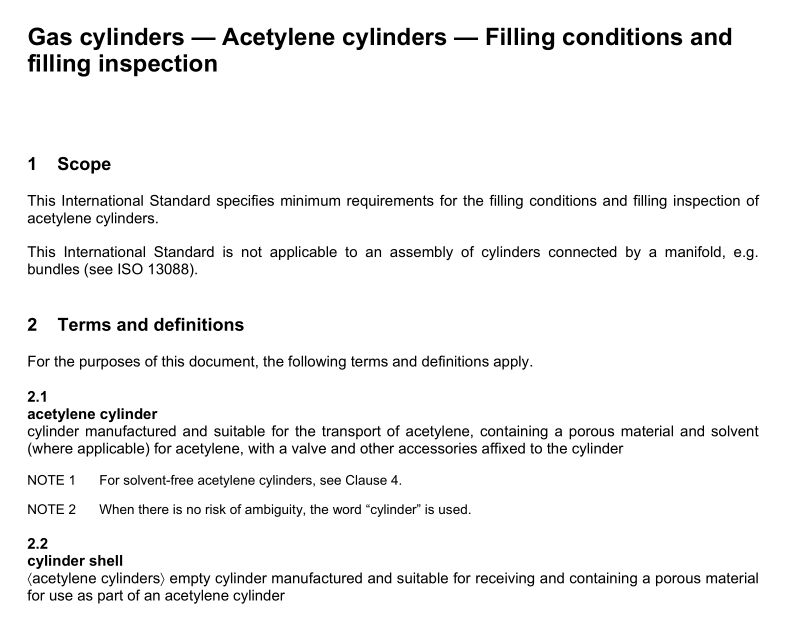ISO 11372 pdf download

ISO 11372 pdf download Gas cylinders — Acetylene cylinders — Filling conditions and filling inspection
3Filling inspection3.1General
Each cylinder shall be submitted to an inspection prior to, during and immediately after flling. Filling of anacetylene cylinder includes determination of its solvent content and replenishment of its solvent,whereapplicable.The items described in 3.2 to 3.5 shall be covered by a filling inspection.
Cylinders not fulfilling these requirements shall be clearly identified for further treatment according to thewritten procedures of the filling station.
Cylinder owners may request that their authorization be obtained prior to their cylinders being filled. Suchownership shall be established and this authorization obtained before filling the cylinders.
The filling conditions of acetylene cylinders are established based on type testing according to ISo 3807 orother applicable regulations/standards. Filing conditions for acetylene cylinders are shown in the Safeoperating diagram in Annex A, for information.
3.2Pre-fill inspection
3.2.1Verification of stamp-marking and necessary documentation
The information required in the following lists shall be made available to the filler, for example, by providinghim with appropriate documentation and by training.
Before filling an acetylene cylinder, it shall be identified that:
a) the cylinder is permitted for filling in the country of the filling station;b) the cylinder has not exceeded its due date for periodic inspection;c) the cylinder does not have a current history of problems;
d) the stamp marking (in accordance with regional regulatory requirements andlor IlSO 13769) and labelling(in accordance with regional regulatory requirements and/or IS0 7225) are appropriate to acetylene;NOTE For sovent-free acetylene cylinders, additional marking elements according to 4.1 need to be verified.
e) the colour coding (in accordance with regional regulatory requirements andlor regional industry practice),
where applicable, is appropriate to acetylene.
Before filling an acetylene cylinder, the following information shall be made available:1)identification of the porous material;
2type of solvent;
3)specified solvent content;
4) tare (with information whether tare A or tare S is used);
5) total weight and/or its maximum acetylene content (if tare A is used) or its maximum acetylene charge (if
tare S is used).
3.2.2Verification of serviceable condition
lt shall be established that each cylinder is in a serviceable condition before filling. lt shall therefore beestablished that the cylinder is clean and free from foreign material, so that the cylinder can be assessed formechanical damage that would otherwise prevent it from being filled safely,that it does not exhibit anyabnormalities that could impair the safety, including arc burns, severe corrosion, heatlfire damage, or haveany other significant mechanical damage.
Any fusible plug, if fitted, shall be inspected to ensure that it is in a satisfactory condition.
Cylinders that have been found to be unserviceable shall be clearly identified and segregated in accordancewith the written procedures of the filling organization, and shall not be filled.
3.2.3Verification of integrity of permanent attachments
Before filing a cylinder, it shall be established that the neck ring/threaded boss is fit for its intended use andthat the neck ring, if one exists, is not loose. lf there is a permanent valve guard,it shall be checked to ensurethat it is in good condition and properly attached.Similarly,the integrity of the foot ring, if fitted, shall bechecked for its intended use.
NOTE lf a permanent valve guard is exchanged, this might affect the tare of the cylinder.3.2.4 Verification of valve integrity and suitability
Before filling a cylinder,it shall be established that the installed valve is suitable for acetylene and is in asatisfactory condition.As a minimum, it shall be established that:
a)the valve outlet is suitable for the intended use;
b) the valve is easy to operate;
c) the valve is free from contaminants;
d) the valve operating mechanism is operable (handwheel or key operated); if the valve is suspected to be
blocked,isolate and identify the acetylene cylinder and rectify the blockage in accordance with anappropriate procedure, e.g. as described in lso 25760;
e) the fusible plug, where present, is undamaged;
f)the outlet thread and body are undamaged;
g)the filling connector attaches securely to the valve.3.3Solvent content
3.3.1 Determination of solvent content
Before filling an acetylene cylinder with acetylene, its actual solvent content shall be determined by measuringthe pressure,temperature and weight of the cylinder in conjunction with the appropriate documentation.Calibrated weighing scales, manometers and other instruments which have a working range and measuringaccuracy appropriate for the cylinder size to be filled shall be used.









